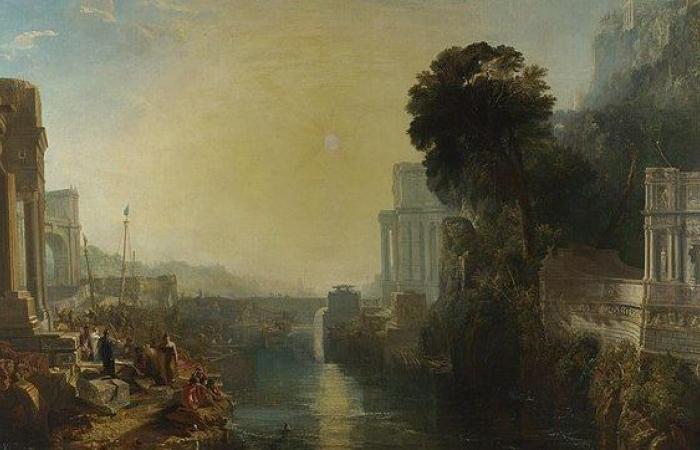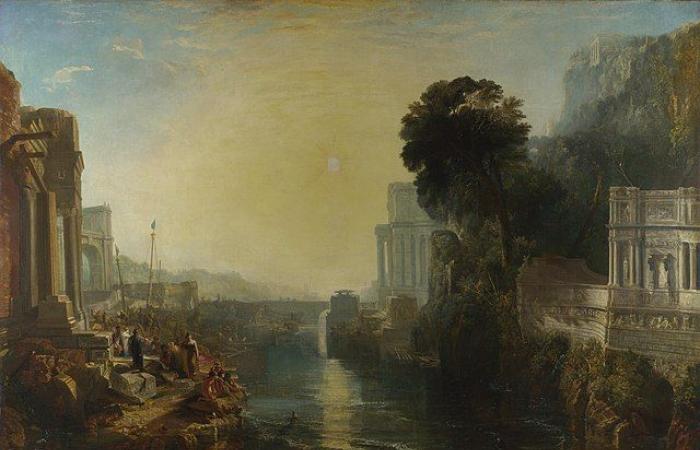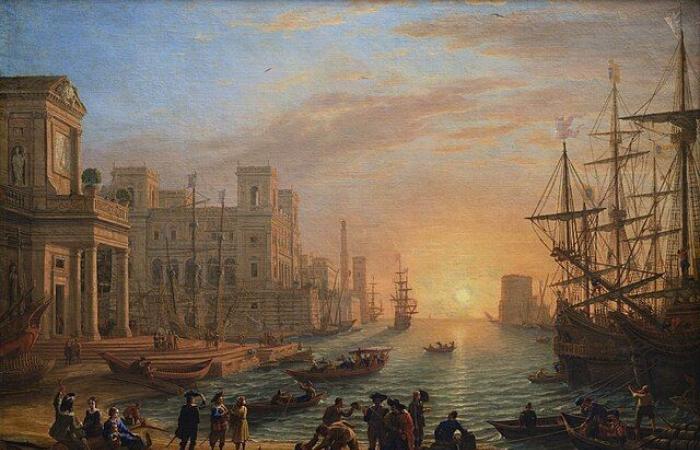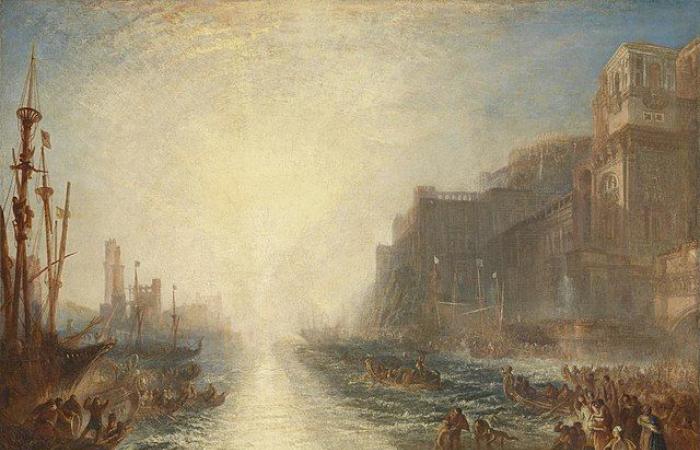” The most beautiful creator of mystery in art “, said the composer Debussy of JMW Turner. It is musically that we should be able to speak of painting, in order to let it come to us at its own pace, without forcing anything. This is what Gilles Deleuze, philosopher of the refrain and repetition, knew admirably, who especially did not want the concept to impose itself on the image. ” What philosophy expects from painting is something that only painting can give it. “, he said in his lectures at the University of Vincennes in the spring of 1981, published by Éditions de Minuit under the title On the painting. It was this book that made us want to go and see it, since it says this somewhat mysterious thing that where everything dissolves in color, there is the painting that is a catastrophe. But when we say that, we think above all of the last Turner, the one of mists and dazzle.
So not so fast: let’s go back to 1815 today, to look at a painting, Dido Building Carthage or the Rise of the Carthaginian Empirean oil on canvas whose subject is taken from theAeneid of Virgil and who has not yet given up on neoclassical composition. Something rises, something else collapses, let’s say it’s the beginning of the end. Let’s see, with our two guests: Pierre Watprofessor of art history at the University of Paris 1 Panthéon-Sorbonne, specialist in European Romanticism, who notably signed Wanderings. Landscapes between nature and history (Hazan, 2017) and Turner the magnificent liar (Hazan, 2010); and Anouchka Vasaklecturer in French literature, eighteenth-century scholar, who works on the history of meteorology and its perception, and to whom we owe the work 1797. For a meteoric story (Anamosa, 2022).
Unlearning the Classical Tradition: From One Turner to Another
Painted in 1815, Dido building Carthage is a table ” on the ridge ” according to Pierre Wat. We are at the height of the first Turner, that is to say the one who is still in the neoclassical composition, as evidenced by the central perspective diagram of the work that concerns us. Nevertheless, this large painting by the first Turner is also a transitional painting towards his second manner, the one where the mode of perception of the order of the diffuse will take on more and more materiality, the historian explains to us.
“ He is not someone who forgets the classical tradition, he begins by ingesting it and then unlearning it in an extremely methodical way. […] Turner is an apocalyptic painter in some ways, but catastrophe is for him a fertile chaos. He is not at all an artist of destruction, he is a painter of unlearning but to return to that original moment from which a world can emerge. He seeks to put things totally in motion again. » Pierre Wat
Dido building Carthage is a painting in homage to Claude Gellée, known as Le Lorrain, a French painter whose works he saw a lot in Italy and England. The subject itself is what is called “a Claudian port”. We also find the influence of the man he considered his master in the lack of readability of the main characters. In Claude Gellée, known as Le Lorrain, as in JMW Turner, history is not easily given.

Without daring to ask Listen later
Reading listen 58 min
A meditation on time and history
Dido building Carthage forms a diptych with The Decline of the Carthaginian Empirepainted two years later, in 1817, reminds us Anouchka Vasak. JMW Turner was in fact in the habit of painting his pictures in duo, with the peak first and then the decline. “ He is a man who has a real philosophy of History, he is obsessed by the question of History and catastrophe. ” explains Pierre Wat. As evidenced by the poem Fallacies of Hope which he wrote throughout his life, and whose title could be translated as “the disillusions of hope”. Let us also note that, obsessed by the question of time, but also of the future, Turner will bequeath the entirety of his work to the British nation. Dido building Carthage is the first legacy of his lifetime to the nation.
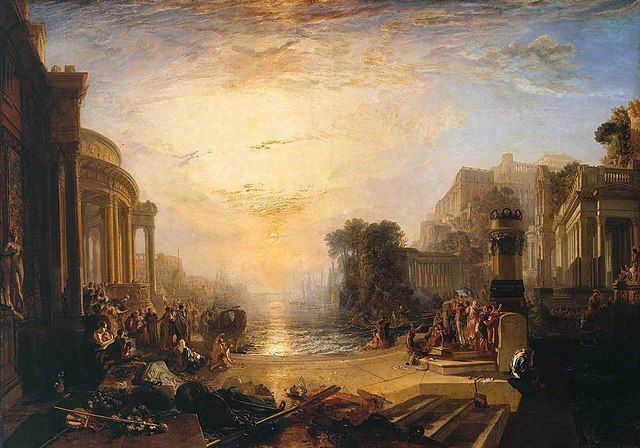
Temporality and History are also embodied in this work in a completely different way. Indeed, from April 5 to 11, 1815 in Indonesia, Tambora, a Javanese volcano, erupted. It was the most colossal volcanic event ever recorded, producing a noise that was heard in Sumatra 2,000 kilometers away and a rain of ash that vaporized in the stratosphere, circled the globe, before shielding the sun’s rays. An event that is not unrelated to the work that interests us, emphasizes climate historian Anouchka Vasak, since ” Paintings like this one, or like Turner’s Chichester Canal, depict skies that are truly typical of the aftermath of the Tambora eruption. “. Dido building Carthage is therefore a product of bad weather, like the famous Frankenstein by Mary Shelley, which the writer wrote in 1816. For Pierre Wat, the two works have in common the question of shock, ” this effect produced by the terror which arises from the story experienced in the mode of catastrophe “.
Great Crossing: Frankenstein! Welcome to the World of Artificial Creatures Listen later
Reading listen 01h 50
“The Sun is God”, or how to paint blindness
In his work 1797. For a meteoric story (Anamosa, 2022), Anouchka Vasak explains that JMW Turner is one of the inventors of a mode of perception of the order of the diffuse. His work participates in a new way of representing the world that is developed at the end of the 18th century and which shows it without contours, without limits, without borders.
Pierre Wat believes that ” Turner’s entire evolution until the end will be a way of intensifying this luminous effect of blindness and arriving at works that are more and more limited since they place the spectator in this kind of paradox: a painting that one cannot really look at. » How to move from physical to metaphysical sight through the blindness of the human senses? This problem haunts the work of the romantic painter and finds its culmination in the painting Reguluswhich Turner completed in two stages, 1828 and 1837. A work painted from the point of view of the Roman consul Marcus Atilius Regulus, a man whose eyelids have been cut off, which places both Turner and the viewer in this position of blindness.
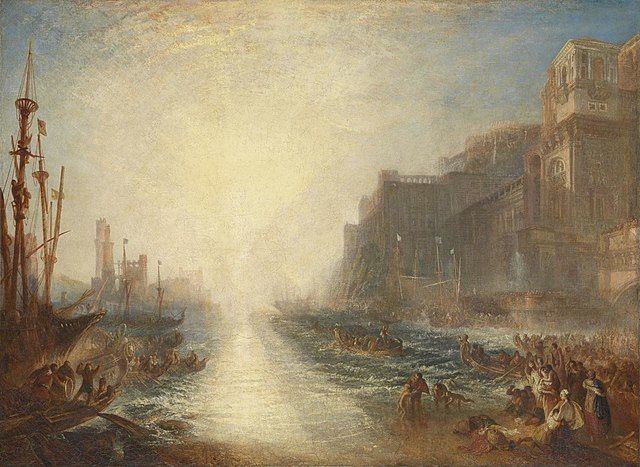
Interested in science, as Anouchka Vasak tells us, JMW Turner was interested in the new theories of light of his time that questioned Newton’s, the so-called corpuscular theory, in favor of the discovery of the vibratory nature of light. Problems that the painter translates pictorially, since his work seeks to give body to light, literally. What we see materially in Turner’s painting is that in his work, what is most formless in nature and most material in painting “, underlines Pierre Wat in this sense.
Painting on fire? Turner, Deleuze, and the arsonists of art: the intervention of Mathieu Potte-Bonneville, member of the program
Every week, at the end of the program, a member of our invisible academy alerts us to another type of image, related or not to the one we have been wandering through, to give us news of our way of being in the world.
At the end of the broadcast, Pierre Wat And Anouchka Vasak are joined by Mathieu Potte-Bonnevillemember of our invisible academy, who takes us into the experiences of recent times, and the works to which they can give rise…
Bibliography:
- Wanderings. Landscapes between nature and history, Pierre Wat, Hazan, 2017
- Turner the magnificent liarPierre Wat, Hazan, 2010
- 1797. For a meteoric story, Anouchka Vasak, Anamosa2022
- On the paintingGilles Deleuze, edition prepared by David Lapoujade, Editions de Minuit, 2023
The Course of History Listen later
Reading listen 58 min
Sounds broadcast during the show:
- Generic and Imaginary Museum by Pierre Boulez, 1972
- FrankensteinORTF, 1974
- Excerpt from Dido and AeneasHenry Purcell, by Les Arts Florissants
- Excerpt from Gilles Deleuze’s course, March 31, 1981.
- Thunderstormby Alexandre Delano.
- Excerpt from the film Full Metal Jacket by Stanley Kubrick, 1987

